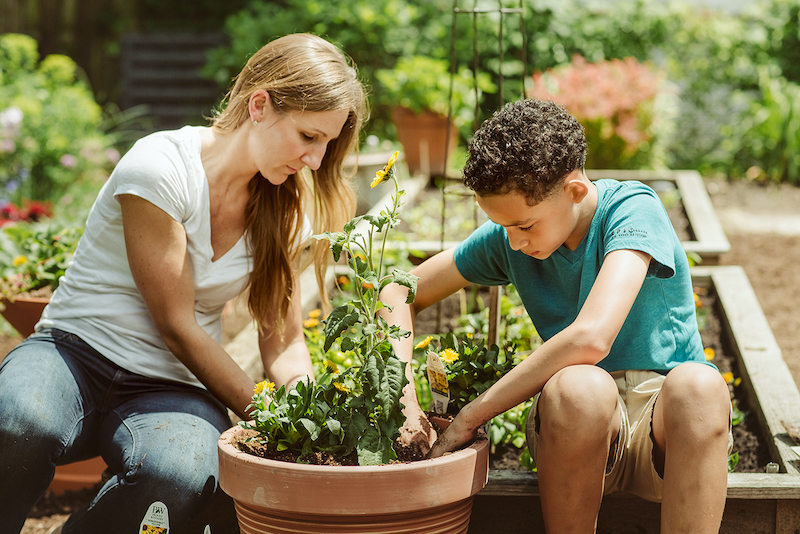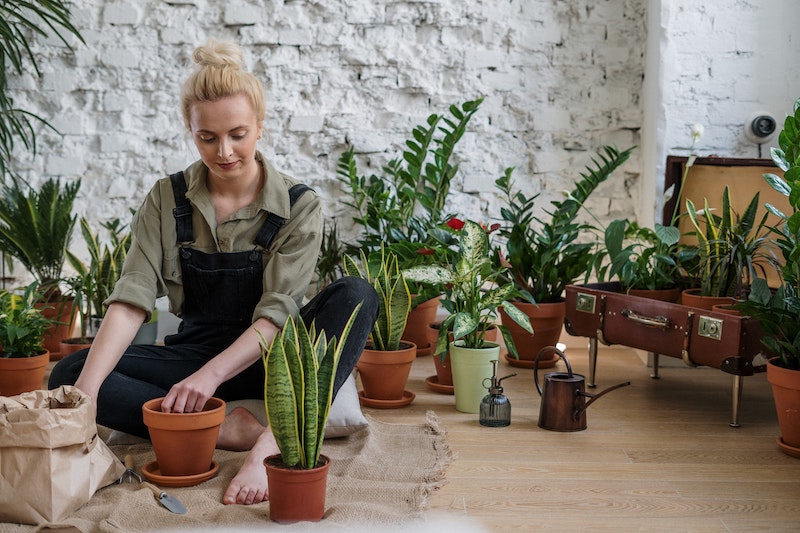When deciding what size containers should be used for plants, the size of the root ball is more important than the size of the plant itself. Select a container that will allow the roots to grow, but not swim in excessive wet soil. The size of the top-growth is important in deciding how sturdy the planter base needs to be to keep the plant upright. If you are creating a mixed planting, choose plants with similar light and water needs, and select a planter that will accommodate the rootball of the largest plant in the group.

How Big Should a Planter Be?
When choosing a container in which to place new plants, be sure to choose one that is, at the very least, one inch in diameter larger than the root ball. This gives the roots room to grow, but not so much room that the plant(s) will spend energy trying to fill the space instead of growing new foliage and flowers.
For fast-growing plants, use a pot up to three or four inches larger than the root mass, so they will not need to be repotted soon. Frequent transplanting risks damaging the roots. This applies to outdoor plants and planters as well as containers for houseplants. Narrow but deep pots are better suited for plants that prefer moist soil; plants that thrive in dry conditions, will do better in containers that are wide and shallow.
Can Pots Be Too Big for Plants?
Pots and containers can absolutely be too large for plants. It’s difficult to water a plant correctly in pots that are too big for them.
Planters that are too big for a plant and its root system, can cause the soil to take too long to dry, holding an excessive amount of moisture against the roots, eventually causing root rot. Soil that is too wet can promote mold growth, cause diseases, and inhibit nutrient and oxygen absorption by the roots, thereby smothering the plant.
At the other end of the spectrum, too much soil in a container that is too big for a plant can make it easy to under-water also. The excess potting soil may absorb all the water before it ever gets to the roots.

Can Containers Be Too Small for Plants?
Conversely, a pot can also be too small. In a too-small container, soil will dry out much more quickly, and it may be difficult to water frequently enough.
In planters that are too small, particularly with plants and flowers that have large root systems, roots may take up so much room that they push the potting mix out of the container, depriving themselves not only of necessary nutrients, but also of water, which may flow straight through the pot. You might notice that plants are wilting and drooping, or flowers and foliage appear dry or crispy.
If you need to size up, choose a container diameter between one inch (for slower growers) and four inches (for faster growers) larger than the original pot. A pot that is too small can also stunt the growth of the roots and eventually, the plant. Containers that are too small for their inhabitants might become top-heavy and may tip or blow over more easily.
How Deep Do Planters Need to Be?
The depth of a planter is also important. Most annuals have shallow root systems and can do very nicely in planters with a depth of only 8 inches.
Common perennial bulbs, such as tulips or iris, need a deeper container. Large bulbs require a planting depth of 8 inches, which means the planter box should be at least 14 inches deep. Most smaller bulbs are planted at 3 to 4 inches deep, so they would do fine in a planter box with an 8-inch depth.
The container depth for vegetables can vary. Turnips, cucumbers, broccoli, beets, lettuce and green onions can all grow well in a planter box 8 inches deep, but other vegetables, like cabbage, need a depth of at least 10 inches. Vegetables such as tomatoes, carrots and peppers do best in something even deeper, at least 12 inches. To make sure any vegetable root balls have adequate growing space, choose a container 2 inches wider than the root ball and 6 inches deeper.
How to Measure Plant Pots
Retail containers are usually sold by diameter and depth measurements in inches, while nurseries and greenhouses tend to measure by volume.
Round and square plant containers can be measured straight across the top from rim to rim. Stretch your measuring tape from one side to the other, and then from one of the perpendicular edges to the other (length x width). For a round pot, measure from one edge of the container to the other side to find the diameter. To measure the depth, measure with your tape vertically from the bottom of the pot to the top edge.

Considerations for selecting an appropriate pot size:
- The size of the root ball matters as much as the size of the top growth.
- Don’t choose a size that makes it difficult to water properly.
- A container too small can increase watering frequency, inhibit plant growth, and impede absorption of nutrients.
- The depth of the planter is also important. Make sure the depth is 6 inches greater than the depth of the rootball.
- When unsure of the size of the container, measure it using the guide above.
 |
Author Chris Link - Published 3-03-2023 |
